Romanticism and Fantasy: William Wordsworth, Part One
 This post is part of an ongoing series about fantasy and the literary movement called Romanticism; specifically, English Romanticism in the late eighteenth and early nineteenth centuries. The series began with this introductory post, continued with an overview of the neo-classical eighteenth century the Romantics revolted against, considered the Romantic themes in English writing from 1760 to about 1790, then looked at elements of fantasy and Romanticism in France and Germany before returning to England to consider the Gothic. Last time, I looked closely at the work of William Blake. And in this post (and its sequel) I want to consider perhaps the least overtly fantastic of all major Romantic poets: William Wordsworth.
This post is part of an ongoing series about fantasy and the literary movement called Romanticism; specifically, English Romanticism in the late eighteenth and early nineteenth centuries. The series began with this introductory post, continued with an overview of the neo-classical eighteenth century the Romantics revolted against, considered the Romantic themes in English writing from 1760 to about 1790, then looked at elements of fantasy and Romanticism in France and Germany before returning to England to consider the Gothic. Last time, I looked closely at the work of William Blake. And in this post (and its sequel) I want to consider perhaps the least overtly fantastic of all major Romantic poets: William Wordsworth.
Like Blake, Wordsworth was concerned with the visionary nature of poetry, and with the character of his own poetic vision. Unlike Blake, he did not explore his vision through fantasy. He claimed to take as his subject the “simple produce of the common day,” and much of the newness of his verse came in the realism of his depiction of human personality, especially that of children and the poor — people who had for the most part not been looked at seriously in poetry up to that time. Nevertheless, I’ve always felt that there was something fantastic in Wordsworth’s verse. Some of that is a function of his preferred imagery. Some of that has to do with his themes.
Wordsworth is one of the great nature poets in the language — and in this makes a strong contrast to Blake, who felt that nature was significant only to the extent that it was transmuted by human imaginative vision. The interplay of vision and nature in Wordsworth is more complex, and accounts for some of the fascination of his work. I think that the way he works out that duality verges on the fantastic; how he deals with his material uses imagery and structures that would later become characteristic of what we think of as fantasy fiction. A critic named A.C. Bradley once wrote that “The road into Wordsworth’s mind must be through his strangeness and his paradoxes, and not round them.” I want, then, to explore here one of those paradoxes: how the depiction of nature and the everyday attains a sense of the fantastic.
 To begin with some biography: Wordsworth was born in 1770. His father, John, was a legal representative of a powerful landowner in the north-west of England, and although not wealthy, the family was comfortably well-off. Besides three brothers, Wordsworth had a sister, Dorothy, who was closest to him in age and temperament; she’d live with him for much of his adult life, and several of the observations in her journals would find their way into his poetry. Wordsworth’s mother died early in 1778 when he was seven, and his distant father died in 1783. He’d already started in boarding school, which he attended from 1779 to 1787; 1787 was also the year his first poem was published.
To begin with some biography: Wordsworth was born in 1770. His father, John, was a legal representative of a powerful landowner in the north-west of England, and although not wealthy, the family was comfortably well-off. Besides three brothers, Wordsworth had a sister, Dorothy, who was closest to him in age and temperament; she’d live with him for much of his adult life, and several of the observations in her journals would find their way into his poetry. Wordsworth’s mother died early in 1778 when he was seven, and his distant father died in 1783. He’d already started in boarding school, which he attended from 1779 to 1787; 1787 was also the year his first poem was published.
Powerfully affected from a young age by the natural world around him, Wordsworth was also strongly influenced by literature and fiction. His first poem was written in praise of the work of a popular poet named Helen Maria Williams. It has been said that much of his earlier verse was strongly influenced by Gothic romances; but Wordsworth was never a strong plotter, and this influence comes through mainly in atmosphere and tone, as well as in his strong sense of nature.
In 1787 Wordsworth went to Cambridge as an undergraduate, and in the summer of 1790 surprised his friends and family by going on a three-month walk through France, Switzerland, and Italy. The French Revolution was then in an early, promising phase, and Wordsworth, travelling through the country, saw it for himself. After graduating Cambridge in 1791, still financially supported by his family, he returned to France. In theory this was to get a firmer grasp of the French language, which would allow him to serve as a tutor to rich youths on their Grand Tour — a journey through Europe often taken by upper-class young men, exposing them to the culture and society of the continent. As it happened, in December of that year Wordsworth met and fell in love with a woman named Annette Vallon.
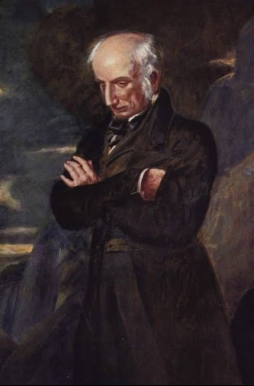 Four years older than Wordsworth, outgoing and vivacious where he was restrained, Vallon’s sympathies were mostly with the royalists. This didn’t seem to affect Wordsworth’s feelings for the Revolution; but then, one of his great friends in France, Michel-Arnaud Bacharétie de Beaupuy, was a Revolutionary soldier. At any rate, by April of 1792 Annette was pregnant with Wordsworth’s child. Political and religious differences between their families would have made marriage difficult under any circumstances, and Wordsworth was running out of money. He returned to England, seeking a way to support Annette. In fact Wordsworth would have difficulty supporting himself for several years. The outbreak of war between France and England early in 1793 seems to have placed a further obstacle between Wordsworth and Vallon; but much of their relationship is unclear, unrecorded. Wordsworth may have travelled to France late in 1793, or may not; if he did, he may have seen Annette and the daughter she’d borne, Caroline, or again he may not. He did acknowledge his paternity of Caroline, and in later years would support her financially. But his relationship with Annette seems to have faded, though it may not have fully ended until 1802.
Four years older than Wordsworth, outgoing and vivacious where he was restrained, Vallon’s sympathies were mostly with the royalists. This didn’t seem to affect Wordsworth’s feelings for the Revolution; but then, one of his great friends in France, Michel-Arnaud Bacharétie de Beaupuy, was a Revolutionary soldier. At any rate, by April of 1792 Annette was pregnant with Wordsworth’s child. Political and religious differences between their families would have made marriage difficult under any circumstances, and Wordsworth was running out of money. He returned to England, seeking a way to support Annette. In fact Wordsworth would have difficulty supporting himself for several years. The outbreak of war between France and England early in 1793 seems to have placed a further obstacle between Wordsworth and Vallon; but much of their relationship is unclear, unrecorded. Wordsworth may have travelled to France late in 1793, or may not; if he did, he may have seen Annette and the daughter she’d borne, Caroline, or again he may not. He did acknowledge his paternity of Caroline, and in later years would support her financially. But his relationship with Annette seems to have faded, though it may not have fully ended until 1802.
It’s generally difficult to track Wordsworth’s activities and thinking during these times. In his later years, it was often politically embarrassing to have been too fervent an ideological ally of the French Revolutionaries during the 1790s, and he, like many older men, downplayed the radical sentiments of youth. Wordsworth seems to have still been enamoured of the ideals of the Revolution through the 1790s, and in 1795 may have been involved in the publication of a liberal journal called the Philanthropist. Still, some biographers have seen a falling-off in his political interests by the middle of the decade, perhaps linked to the turn of events in France. Given his ongoing concern with poverty, though, one might also speak of the expression of Wordsworth’s politics shifting, becoming broader and yet also more concrete, as he presented in his poetry the lives of poor men and women with unprecedented realism.
He had published his first collections of verse, Descriptive Sketches and An Evening Walk, after returning to England in 1793. In 1795 he received an inheritance from a dead freiend, an annuity that allowed him to live, however poorly, and write. That year he met a fellow-poet, Samuel Taylor Coleridge; I’ll have much more to say about Coleridge in a later post, but what’s important for now is that he was an accomplished writer, and an insightful critic. He helped define Wordsworth’s poetical views, as they discussed ideals and ambitions, and enthusiastically praised Wordsworth’s poetry. The two men became fast friends, and in 1797 Wordsworth and his sister moved to live near Coleridge in Somerset.
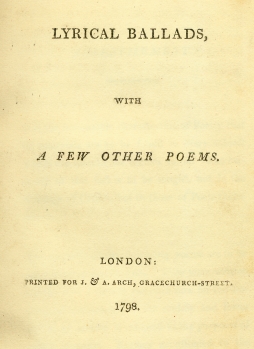 Wordsworth had written a verse drama, The Borderers, with a gothic atmosphere; it was rejected by London’s Covent Garden theatre late in 1797, and Wordsworth did nothing further with it. He had other plans. In March of 1798 he discussed an epic to be called The Recluse; then, between March and May, wrote a series of short poems to be published as a volume along with several pieces by Coleridge. The aim was to raise money for William and Dorothy Wordsworth to travel with Coleridge to Germany to study the German language and contemporary German philosophy — notably the post-Kantian idealist philosophy developing around the university town of Jena, where Friedrich Schlegel was establishing the principles of a new movement he called ‘Romanticism.’
Wordsworth had written a verse drama, The Borderers, with a gothic atmosphere; it was rejected by London’s Covent Garden theatre late in 1797, and Wordsworth did nothing further with it. He had other plans. In March of 1798 he discussed an epic to be called The Recluse; then, between March and May, wrote a series of short poems to be published as a volume along with several pieces by Coleridge. The aim was to raise money for William and Dorothy Wordsworth to travel with Coleridge to Germany to study the German language and contemporary German philosophy — notably the post-Kantian idealist philosophy developing around the university town of Jena, where Friedrich Schlegel was establishing the principles of a new movement he called ‘Romanticism.’
The resulting book was called Lyrical Ballads; much has been written about it over the years, not least by Wordsworth and Coleridge themselves. The book’s come to be seen as one of the core texts of English Romanticism (and one of the most important books of poetry in the language), inaugurating a revolution in poetic form. The title’s sometimes seen as a deliberate contradiction: both lyrics and ballads were designed to be sung, but a ballad, popular and usually narrative, was not typically thought of as personal in the manner of a ‘lyric’. The suggestion of a new form is a hint that Wordsworth and Coleridge were doing new things in the book. Wordsworth’s poems in particular consciously rejected typical eighteenth-century poetic diction, aiming not only at realism but at creating a new and more direct language with which to handle his subjects.
If there was much new and striking in the book, it is still possible to see its contemporary influences. A ballad revival had been underway in England for a generation, inspired by Thomas Percy’s collection of Reliques of Ancient English Poetry. A German ballad, Gottfried Bürger’s “Lenore,” had been translated into English in 1790 and the translation published to great acclaim in 1796. The book therefore has its place in both the literary and popular traditions of its time; but more importantly, it also did new and previously unattempted things.
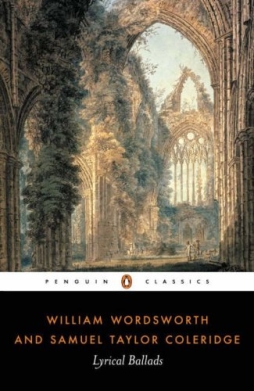 Most of the poems in the book were by Wordsworth, many of them written in the burst of creativity of the months just previous. Coleridge wrote four poems for the book, including the first and longest piece, “The Rime of the Ancient Mariner.” The last poem in the book — and last written, being composed in mid-July for a book published on October 4 — was Wordsworth’s “Lines written a few miles above Tintern Abbey.” Coleridge’s opening piece was a wild fantastic story; Wordsworth’s closing work was a moving meditation on revisiting a specific place, neither lyric nor ballad, a complex autobiographical reflection on nature, memory, and time.
Most of the poems in the book were by Wordsworth, many of them written in the burst of creativity of the months just previous. Coleridge wrote four poems for the book, including the first and longest piece, “The Rime of the Ancient Mariner.” The last poem in the book — and last written, being composed in mid-July for a book published on October 4 — was Wordsworth’s “Lines written a few miles above Tintern Abbey.” Coleridge’s opening piece was a wild fantastic story; Wordsworth’s closing work was a moving meditation on revisiting a specific place, neither lyric nor ballad, a complex autobiographical reflection on nature, memory, and time.
This seems to fit in with the general plan by which the writers divided their work on the book. According to Coleridge, writing in 1817, “my endeavours were to be directed to persons and characters supernatural, or at least romantic; yet so as to transfer from our inward nature a human interest and a semblance of truth sufficient to procure for these shadows of imagination that willing suspension of disbelief for the moment, which constitutes poetic faith. Mr. Wordsworth, on the other hand, was to propose to himself as his object, to give the charm of novelty to things of every day, and to excite a feeling analogous to the supernatural, by awakening the mind’s attention from the lethargy of custom, and directing it to the loveliness and the wonders of the world before us; an inexhaustible treasure, but for which in consequence of the film of familiarity and selfish solicitude we have eyes, yet see not, ears that hear not, and hearts that neither feel nor understand.” Wordsworth remembered the idea of the book coming in November 1797, when he helped Coleridge compose “The Rime of the Ancient Mariner,” “and we began to talk of a volume which was to consist … of poems chiefly on natural subjects taken from common life but looked at, as much as might be, through an imaginative medium.” Since Coleridge produced only four poems for the book, both statements are effectively accurate. As he said: “Mr. Wordsworth’s industry had proved so much more successful, and the number of his poems so much greater, that my compositions, instead of forming a balance, appeared rather an interpolation of heterogeneous matter.”
The book sold steadily, if not especially well. Coleridge’s good friend Robert Southey gave it a negative review, but later comments, coming in 1799, were more favourable. Wordsworth, his sister, and Coleridge had left England in September, 1798, just before the book came out. Once in Germany, they split up, so that Coleridge could pursue his studies; it was during these months that Wordsworth began writing the epic he’d spoken of in March. More precisely, he began a long introduction or prelude to the epic, in the form of a poem, addressed to Coleridge, whose subject was the growth of Wordsworth’s own mind. Returning to England in 1799, Wordsworth lived for a time with childhood friends, the Hutchinsons, striking up a romance with one of the family, Mary Hutchinson. In 1800, he published a new two-volume edition of Lyrical Ballads.
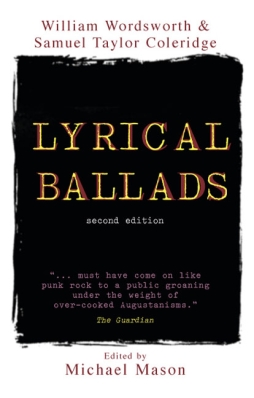 Wordsworth originally wanted to change the name of the book for the new edition, but his publisher refused. In addition to several new poems, Wordsworth added a new preface to his book explaining the ideas underlying his work. The reviews were strong, and it sold out in half a year, a considerable sales success. In 1802 he expanded the preface and reworked some of the poems. Some have argued that the revised preface doesn’t add up logically, but whether or not the ideas fit into a coherent framework, they had a powerful resonance. For Wordsworth, poetry “is the spontaneous overflow of powerful feelings: it takes its origin from emotion recollected in tranquillity.” The poet has “a disposition to be affected more than other men by absent things as if they were present.”
Wordsworth originally wanted to change the name of the book for the new edition, but his publisher refused. In addition to several new poems, Wordsworth added a new preface to his book explaining the ideas underlying his work. The reviews were strong, and it sold out in half a year, a considerable sales success. In 1802 he expanded the preface and reworked some of the poems. Some have argued that the revised preface doesn’t add up logically, but whether or not the ideas fit into a coherent framework, they had a powerful resonance. For Wordsworth, poetry “is the spontaneous overflow of powerful feelings: it takes its origin from emotion recollected in tranquillity.” The poet has “a disposition to be affected more than other men by absent things as if they were present.”
It is worth noting here that one passage in the preface has been viewed as Wordsworth emphatically turning his back on his previous sympathies with the Gothic. He worries that
… a multitude of causes, unknown to former times, are now acting with a combined force to blunt the discriminating powers of the mind, and, unfitting it for all voluntary exertion, to reduce it to a state of almost savage torpor. The most effective of these causes are the great national events which are daily taking place, and the encreasing accumulation of men in cities, where the uniformity of their occupations produces a craving for extraordinary incident which the rapid communication of intelligence hourly gratifies. To this tendency of life and manners the literature and theatrical exhibitions of the country have conformed themselves. The invaluable works of our elder writers, I had almost said the works of Shakespeare and Milton, are driven into neglect by frantic novels, sickly and stupid German Tragedies, and deluges of idle and extravagant stories in verse.
In other words: politics and urbanisation are leading to distraction and a search for sensation. So taste is degraded, and bad novels, bad plays, and bad poetry take over. It seems to be a commonplace among modern critics that “frantic novels” is meant to refer to the Gothic. It’s not clear to me why that is; much seems to be read into the adjective. Certainly other novels no more highly regarded were being published at the time. It is true that the “German Tragedies” then ruling the London stage were mostly Gothic in style, but Wordsworth would have had other reasons for reacting against them: none of them have lasted as drama. It may be relevant that the very real success of German plays in England had led some English critics to speak out against them.
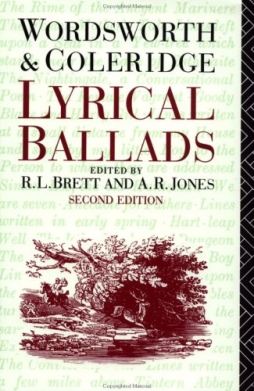 At any rate, the new edition of the book was a considerable success. 1802 also saw a brief peace between France and England, leading to a meeting between Wordsworth and Annette Vallon that apparently resolved their relationship. At any rate, not long after, Wordsworth married Mary Hutchinson. Wordsworth had returned to the introductory poem to his projected epic, and now began to expand it; it grew from two books to five to thirteen, an epic in itself. He would finish it in 1805, but chose not to publish it until he had finished the whole of The Recluse, the epic it would introduce. But while Wordsworth would produce fragments of that work over time, many of which would be published as poems of their own, he never completed the whole of his projected Recluse. The introductory poem was thus never published during his life, but remained set aside for him to tinker with from time to time.
At any rate, the new edition of the book was a considerable success. 1802 also saw a brief peace between France and England, leading to a meeting between Wordsworth and Annette Vallon that apparently resolved their relationship. At any rate, not long after, Wordsworth married Mary Hutchinson. Wordsworth had returned to the introductory poem to his projected epic, and now began to expand it; it grew from two books to five to thirteen, an epic in itself. He would finish it in 1805, but chose not to publish it until he had finished the whole of The Recluse, the epic it would introduce. But while Wordsworth would produce fragments of that work over time, many of which would be published as poems of their own, he never completed the whole of his projected Recluse. The introductory poem was thus never published during his life, but remained set aside for him to tinker with from time to time.
Wordsworth published another collection of poems in 1807, highlighted by what is now regarded as one of his greatest works, the “Ode: Intimations of immortality from Recollections of Early Childhood.” At the time, though, critics weren’t especially receptive to the poem; the book didn’t do especially well. Today, it’s often said that the publication of this book marked the end of the period of Wordsworth’s best work — his “great decade.” This would not have been immediately apparent to Wordsworth or his contemporaries. He continued to write, with greater and greater commercial success.
Wordsworth’s friendship with Coleridge grew strained; Coleridge was increasingly dependent on opium and harbouring a desperate unrequited love for Mary’s sister Sara. A rift developed between the two men following an argument in 1810. Reconciliation was slow in coming, and they seem never to have become as close as they once were.
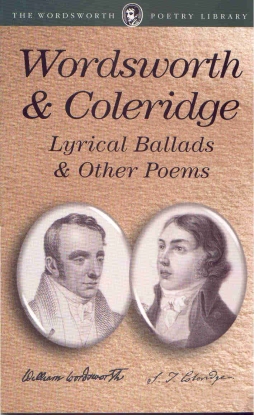 In 1813, Wordsworth was appointed Stamp Distributor (or revenue collector) for Westmorland; it was a sinecure, a form of recognition for his poetry. In 1814 he published a long poem called The Excursion that was to have been the second of three parts of The Recluse; in the next year, in a collected edition of his works, he included a “Prospectus” in verse for the whole of the unwritten epic.
In 1813, Wordsworth was appointed Stamp Distributor (or revenue collector) for Westmorland; it was a sinecure, a form of recognition for his poetry. In 1814 he published a long poem called The Excursion that was to have been the second of three parts of The Recluse; in the next year, in a collected edition of his works, he included a “Prospectus” in verse for the whole of the unwritten epic.
In 1819, after canvassing on behalf of a victorious Parliamentary candidate, he was made a Justice of the Peace. The culture was changing, and Wordsworth was changing with it. England was a more conservative environment now than it had been in the 1890s, and Wordsworth, as he aged, grew more conservative as well. Even as the power of his verse declined, he became increasingly well-known as a national poet; in 1843 he was named England’s poet laureate. He died in 1849, having completed before his death a final revision of the poem on his own mind, which was finally posthumously published as The Prelude.
There is a notable absence of the overtly fantastic in most of Wordsworth’s poems. He did write some works with a supernatural flavouring — The White Doe of Rylstone is a long dramatisation of a local legend, “The Egyptian Maid” is an Arthurian poem, and “Laodamia” tells the story of the widow of the first Greek to die in the Trojan war summoning her husband’s shade to speak with him for a final time. Wordsworth himself valued The White Doe highly, and “Laodamia” certainly has interesting aspects; but still neither of these works are central to his poetic accomplishments in the way that Jerusalem was central to Blake’s work or, say, Prometheus Unbound was central to Shelley. So how does Wordsworth connect to the fantastic?
 To explain why I think he’s relevant to fantasy, I want to turn to The Encyclopedia of Fantasy, which outlined several structural motifs that the book’s editors, John Clute and John Grant, saw recurring in fantasy stories (at least fantasy from within the Western tradition). Note that Clute, who wrote the defintion of “fantasy”, drew a distinction between ‘stories’ and ‘texts’, identifying “fantasy” as “a self-coherent narrative”; to an extent I disagree. I think that the motifs he and Grant found may come through most clearly in stories, but can be found in other works as well. So while Clute uses this point to distinguish “the enterprises of Modernism and Postmodernism” from fantasy, personally, at least in this context, I don’t feel a need to do so. I think the motifs identified in the Encyclopedia are best viewed as archetypal structures that tend to shape texts generated through or with a certain kind of creative impulse or impulses — which may be called non-mimetic, mythical, or visionary. Stories take a certain shape from these motifs, but non-narrative works can gain form from them as well, including, I feel, much of Wordsworth’s poetry.
To explain why I think he’s relevant to fantasy, I want to turn to The Encyclopedia of Fantasy, which outlined several structural motifs that the book’s editors, John Clute and John Grant, saw recurring in fantasy stories (at least fantasy from within the Western tradition). Note that Clute, who wrote the defintion of “fantasy”, drew a distinction between ‘stories’ and ‘texts’, identifying “fantasy” as “a self-coherent narrative”; to an extent I disagree. I think that the motifs he and Grant found may come through most clearly in stories, but can be found in other works as well. So while Clute uses this point to distinguish “the enterprises of Modernism and Postmodernism” from fantasy, personally, at least in this context, I don’t feel a need to do so. I think the motifs identified in the Encyclopedia are best viewed as archetypal structures that tend to shape texts generated through or with a certain kind of creative impulse or impulses — which may be called non-mimetic, mythical, or visionary. Stories take a certain shape from these motifs, but non-narrative works can gain form from them as well, including, I feel, much of Wordsworth’s poetry.
Before specifying the motifs I mean, two points are worth noting here. The first is that one can of course take argument with the definitions and the motifs Clute and Grant suggest, and cite stories that challenge or avoid these structures. Personally, I look at their definitions as outlines of tendencies, as habits of thought that frequently enter into fantasy narratives. And which sometimes become structures that can be rebelled against or inverted. But I do feel that their observations accord with my own experience of fantasy and the fantastic in literature; and so are useful to me in explaining why certain texts that aren’t explicitly fantasy feel as though they are.
The second point is that it is perhaps possible to argue that the development of these motifs in fantasy came through the influence of Wordsworth’s poetry on later writers. Most of the fantasies Clute and Grant looked at came after Wordsworth’s writing; and of course the reason why I feel Wordsworth and the Romantics are worth writing about in a fantasy context is that I want to argue that they are at the fountainhead of fantasy fiction. Still, there’s a reason why post hoc ergo propter hoc is a fallacy. Just because one thing happens after another thing does not mean it was caused by the other thing, and I haven’t noticed a particularly large number of conscious echoes and quotations of Wordsworth in fantasy (I note that Tolkien seems to have disliked his verse). So I think specific influence here is unlikely, although impossible to disprove.
So with these things said, what fantasy motifs do I find in Wordsworth? I’ll start with the Encyclopedia’s entry on the subject of “Land”:
A land is a venue located in a secondary world — and in certain kinds of secondary world only. The mere backdrop to the action … is not a land but simply a venue. For our purposes a land may be defined as a secondary-world venue whose nature and fate are central to the plot: a land is not a protagonist, but has an analogous role. Some or all of the following will almost certainly be the case: the land may evidence wrongness; it may be subject to thinning; it may be a waste land; it may suffer (or be saved by virtue of) a fundamental transformation; it can be healed; and it is almost certainly, in some sense, alive.
The entry goes on to note that early secondary-world fantasies frequently involved such a land, citing Morris, Eddison, Tolkien, and Alan Garner. I think Wordsworth’s use of the natural world is in many ways similar to the secondary-world land described above. Only his “land” is our world; for Wordsworth, this reality serves the purpose of the secondary world.
 Several cross-references from the above definition may help make that clear: “wrongness” is defined as “the apprehension of some profound change in the essence of things … a recognition that the world is — or is about to become — no longer right.” “Transformation” is “a magic and radical change in shape experienced, normally through an act of will, by its subject” brought on by an “external agent of change.” And “healing” in this context is “one of several central terms which help describe the narrative course of the fully structured fantasy tale. … It is what occurs after the worst has been experienced and defeated. It is the greening of the waste land or the recovery from amnesia on the part of the hero or the escape from bondage and the metamorphoses into the desired shape and fullness of those who have been wounded/imprisoned by the dark lord. … It is what the story of fantasy ‘wishes’ to tell.”
Several cross-references from the above definition may help make that clear: “wrongness” is defined as “the apprehension of some profound change in the essence of things … a recognition that the world is — or is about to become — no longer right.” “Transformation” is “a magic and radical change in shape experienced, normally through an act of will, by its subject” brought on by an “external agent of change.” And “healing” in this context is “one of several central terms which help describe the narrative course of the fully structured fantasy tale. … It is what occurs after the worst has been experienced and defeated. It is the greening of the waste land or the recovery from amnesia on the part of the hero or the escape from bondage and the metamorphoses into the desired shape and fullness of those who have been wounded/imprisoned by the dark lord. … It is what the story of fantasy ‘wishes’ to tell.”
Many of the themes touched on in these definitions can be seen in Wordsworth’s poetry. Although nominally realistic, I find their presence gives his work an underlying feel of the fantastic. His perspective on nature specifically seems to me similar to the way nature, or the land, is depicted in fantasy. At times he seems to set up nature as a divine or quasi-divine force; in later life many of his alterations to The Prelude involved softening the tendency to nature-worship in the poem, and making it consciously more orthodox. His nature is typically neither explicitly (though sometimes implicitly) sexualised, nor red in tooth and claw, but rather a nature of meteorology, landscape, and vegetable life — and, still, a nature compelling and convincing. I think some of what makes it so compelling is the fact that it shares the archetypal view of nature, the nature that fosters visionary truth and the sense of meaning, that one finds in fantasy.
Look at his poem “Nutting,” written in 1798, originally intended as part of what became The Prelude and eventually published in the 1800 edition of Lyrical Ballads. It’s a 56-line poem describing an anecdote of a boy encountering the natural world: “I left our cottage-threshold,” he says, evoking the sense of an entry into a new world; and “O’er pathless rocks, / Through beds of matted fern, and tangled thickets, / Forcing my way” he comes at last to a “dear nook unvisited” with “not a broken bough” nor “withered leaves”. In this paradisic spot, “Where fairy water-breaks do murmur on / for ever”, he is “blest with sudden happiness beyond all hope.” But then “up I rose, / And dragged to earth both branch and bough, with crash / And merciless ravage”. The glen is “Deformed and sullied”. But, the poem concludes, “I felt a sense of pain when I beheld / The silent trees, and saw the intruding sky — / Then, dearest Maiden, move along these shades / In gentleness of heart; with gentle hand / Touch — for there is a spirit in the woods.”
 In 56 lines Wordsworth presents an anecdote with the force of myth. The violence done to nature can be read sexually, or as a naturalised version of the Fall, or in any number of ways; it has the polysemous sense of myth, the feel that no one explanation can fully capture the symbolic power of the text. The sense of the boy as a quester or adventurer is strong; as critic Harold Bloom observed, “The difficulty of approach, pathless, matted, tangled, is a feature of many myths of quest that move toward a cynosure, a bower of delight that serves as a center of centripetal vision.” The conclusion, with the Maiden seeming almost to heal or redeem nature, and the evocation of the spirit in the woods, presents another symbolic image that leads to an insistence on the more-than-physical meaning of nature. (Literally, the conclusion is telling the Maiden when she touches and moves in nature to touch and move gently, but the phrasing almost demands that it be taken as an invocation, asking that she touch gently.)
In 56 lines Wordsworth presents an anecdote with the force of myth. The violence done to nature can be read sexually, or as a naturalised version of the Fall, or in any number of ways; it has the polysemous sense of myth, the feel that no one explanation can fully capture the symbolic power of the text. The sense of the boy as a quester or adventurer is strong; as critic Harold Bloom observed, “The difficulty of approach, pathless, matted, tangled, is a feature of many myths of quest that move toward a cynosure, a bower of delight that serves as a center of centripetal vision.” The conclusion, with the Maiden seeming almost to heal or redeem nature, and the evocation of the spirit in the woods, presents another symbolic image that leads to an insistence on the more-than-physical meaning of nature. (Literally, the conclusion is telling the Maiden when she touches and moves in nature to touch and move gently, but the phrasing almost demands that it be taken as an invocation, asking that she touch gently.)
But look at the depiction of nature in this poem, and compare that Encylopedia definition of Land. Its “nature and fate are central to the plot.” It “is not a protagonist, but has an analogous role.” It “suffer[s] (or [is] saved by virtue of) a fundamental transformation; it can be healed; and it is almost certainly, in some sense, alive.” As I said: Wordsworth’s nature has the role of a Land in a fantasy text. His sense of meaning in nature, his perception of nature as allied to visionary perception, is not only similar to the symbolic purpose nature often acquires in a fantasy story, but expresses that symbolism in the same way structurally. There’s nothing magical here, but one might say that nature has the effect of magic.
(A manuscript passage names the Maiden in “Nutting” as ‘Lucy,’ which links her with a series of other poems Wordsworth wrote about a figure named Lucy; it’s not clear whether there was any original for Lucy in Wordsworth’s life, but figuratively she became a way for him to write in a brief yet complex fashion about nature and death.)
 Most resonant, perhaps, with Wordsworth’s themes and indeed life is the concept of “thinning.” The entry for “Thinning” begins by observing that “Fantasy tales can be defined, in part, as fables of recovery,” and notes that among the possible things being recovered may be “the health of the land through a process of healing. … The happy endings of much fantasy derive from the notion that this is a restoration, that before the written story started there was a diminishment. … Thinning can be seen as a reduction of the healthy land to a parody of itself.” Thinning is the dwindling of enchantment: “The passing away of a higher and more intense reality.”
Most resonant, perhaps, with Wordsworth’s themes and indeed life is the concept of “thinning.” The entry for “Thinning” begins by observing that “Fantasy tales can be defined, in part, as fables of recovery,” and notes that among the possible things being recovered may be “the health of the land through a process of healing. … The happy endings of much fantasy derive from the notion that this is a restoration, that before the written story started there was a diminishment. … Thinning can be seen as a reduction of the healthy land to a parody of itself.” Thinning is the dwindling of enchantment: “The passing away of a higher and more intense reality.”
If Wordsworth’s poetic career is an illustration of thinning on an individual level, some of his greatest work has a fear of thinning as a part of its theme. In his poetry the experience of thinning, under whatever name, is a phenomenon actively to be dreaded; though it is a thinning of perception, not a thinning of meaning in the land, but a thinning within the poet or visionary of the visionary awareness of the land. Sometimes, though, there is a consolatory healing brought about by nature. The “Ode: Intimations of immortality from Recollections of Early Childhood,” which Wordsworth instructed should always be placed last in editions of his collected works, is a particular illustration of Wordsworth’s sense of this thinning.
There are eleven sections to the Ode. The first and second lay out the poet’s problem:
There was a time when meadow, grove, and stream,
The earth, and every common sight,
To me did seem
Apparell’d in celestial light,
The glory and the freshness of a dream.
It is not now as it hath been of yore;—
Turn wheresoe’er I may,
By night or day,
The things which I have seen I now can see no more.The Rainbow comes and goes,
And lovely is the Rose,
The Moon doth with delight
Look round her when the heavens are bare,
Waters on a starry night
Are beautiful and fair;
The sunshine is a glorious birth;
But yet I know, where’er I go,
That there hath passed away a glory from the earth.
Thinning here is described through the use of natural imagery, but not as taking place in nature. The second section makes it clear: the problem is not with nature, which has all the beauty it ever did, but with the poet. The visionary, when vision is at its healthiest, can see “celestial light” surrounding the things of nature. The vision in fact puts that dreamlike glory on the natural world as though dressing it in a coat; like a piece of apparel. It may be partially divine, as that quality is like “celestial” light — but is not necessarily so, as the common sights “To me did seem / Apparell’d” in the heavenly light. Either way, now the dream’s faded. The next two parts of the poem expand upon this failure of the imagination. The third section seems to see a partial recovery, only for the poet to fall back into despair in the fourth: “Whither is fled the visionary gleam? / Where is it now, the glory and the dream?”
Wordsworth apparently wrote those first four sections, then struggled to find answers. Sections five through eight propose and critique one possible solution. He begins in section five by saying:
Our birth is but a sleep and a forgetting:
The Soul that rises with us, our life’s Star,
Hath had elsewhere its setting,
And cometh from afar:
Not in entire forgetfulness,
And not in utter nakedness,
But trailing clouds of glory do we come
From God, who is our home:
Heaven lies about us in our infancy!
So the quality of vision is proper to youth, and derives from an existence before birth. Wordsworth argued in a headnote that as he understands the concept, there’s nothing in it that contradicts Christian doctrine; but with respect to the ‘story’ of the poem, I simply want to note that the poet’s effectively referring to a state before the Fall. The time, that is, before the thinning process begins. But, as he goes on to say:
Shades of the prison-house begin to close
Upon the growing Boy,
But he beholds the light, and whence it flows,
He sees it in his joy;
The Youth, who daily farther from the east
Must travel, still is Nature’s priest,
And by the vision splendid
Is on his way attended;
At length the Man perceives it die away,
And fade into the light of common day.
So thinning comes with aging. Cleanth Brooks observed that Wordsworth makes great symbolic play with light, the medium of vision; I’d note that “our life’s Star” is a sun, and that the youth must travel farther from the east where the sun rises — so this is close to a solar myth. It’s an unusual kind of solar myth, one in which dawn light has a power or potential that fades as the sun rises, but myth nevertheless. (I’ll also note tangentially that in the second section of the poem “The Moon doth with delight / Look round her when the heavens are bare;” by ascribing action and emotion to the moon, it almost makes it a character. Again, a step towards myth.)
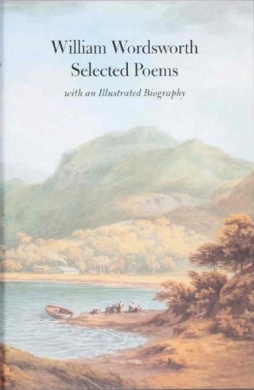 Section six of the poem establishes that the thinning is natural; nature “doth all she can / To make her foster-child, her Inmate Man, / Forget the glories he hath known, / And that imperial palace whence he came.” Parts seven and eight describe the child growing into human society, warning that “Full soon thy soul shall have her earthly freight, / And custom lie upon thee with a weight, / Heavy as frost, and deep almost as life!”
Section six of the poem establishes that the thinning is natural; nature “doth all she can / To make her foster-child, her Inmate Man, / Forget the glories he hath known, / And that imperial palace whence he came.” Parts seven and eight describe the child growing into human society, warning that “Full soon thy soul shall have her earthly freight, / And custom lie upon thee with a weight, / Heavy as frost, and deep almost as life!”
But section nine marks a sudden turn: “O joy! that in our embers / Is something that doth live, / That nature yet remembers / What was so fugitive! / The thought of our past years in me doth breed / Perpetual benediction” — the old sense of glory is returning, in part. As the poet makes clear, it’s brought back by the very awareness of its former existence, by memory contrasting the old state of childhood glory and the new doubts of adult life. The cause of the thinning heals it: “those obstinate questionings / Of sense and outward things, / Fallings from us, vanishings”. So, “Though nothing can bring back the hour / Of splendour in the grass, of glory in the flower; / We will grieve not, rather find / Strength in what remains behind”. It is a tremendous and effective consolation, which allows the poem to conclude:
The clouds that gather round the setting sun
Do take a sober colouring from an eye
That hath kept watch o’er man’s mortality;
Another race hath been, and other palms are won.
Thanks to the human heart by which we live,
Thanks to its tenderness, its joys, and fears,
To me the meanest flower that blows can give
Thoughts that do often lie too deep for tears.
The eye that gives a colouring to the sunset clouds is the visionary eye. The process of aging and maturing have changed it, it hath “kept watch o’er man’s mortality,” but although the character of its vision is different from the glory of youth, there are compensations in a different, perhaps wiser, form of vision — one that involves “Thoughts that so often lie too deep for tears.”
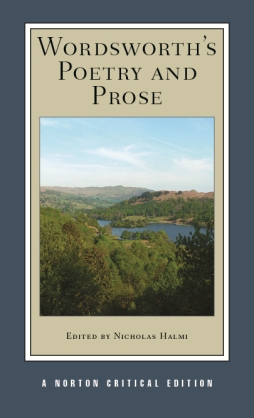 What I see in this poem is the Clute-Grant pattern of thinning, transformation, and healing. It’s not expressed through narrative, but it’s there. Perhaps more significantly, rather than have that process entirely enacted upon the land, Wordsworth’s doing something more intricate: he describes the states of the visionary perceiver of the land. There are points where the land reflects that perception, points also where the process is purely internal. Crucially, it is the land, nature, that enacts the transformation of the poet: causing the child to forget the glories of infancy, but also leading the mature adult to perceive them again, through memory and the consciousness of passing time.
What I see in this poem is the Clute-Grant pattern of thinning, transformation, and healing. It’s not expressed through narrative, but it’s there. Perhaps more significantly, rather than have that process entirely enacted upon the land, Wordsworth’s doing something more intricate: he describes the states of the visionary perceiver of the land. There are points where the land reflects that perception, points also where the process is purely internal. Crucially, it is the land, nature, that enacts the transformation of the poet: causing the child to forget the glories of infancy, but also leading the mature adult to perceive them again, through memory and the consciousness of passing time.
The Ode lays out a myth using a mythic pattern. But it does so without the use of a story. I don’t think it’s unique in Wordsworth’s poetry in doing this thing in this way. “Tintern Abbey,” the concluding poem of Lyrical Ballads, is another example.
It’s a poem in which Wordsworth, visiting a place in 1798, looks back on his last visit to the same place in 1793. The natural scene of the place has sustained him in the interim, on the one hand providing him with feelings “Of unremembered pleasure; such, perhaps, / As may have had no trivial influence / On that best portion of a good man’s life; / His little, nameless, unremembered acts / Of kindness and of love”, but also “more sublime” sensations “In which the burthen of the mystery, / In which the heavy and the weary weight / Of all this unintelligible world / Is lighten’d” — sensations which affect one such that “with an eye made quiet by the power / Of harmony, and the deep power of joy, / We see into the life of things.” So again the link of nature and visionary sight; again the link of sublimity and joy with nature.
In reflecting on these things, he reflects as well on his different reactions to nature. He mentions “The coarser pleasures of my boyish days, / And their glad animal movements” as a state he had already grown out of by the time he first saw the place in 1793; at that time, “nature then … To me was all in all.” The place “had no need of a remoter charm, / By thought supplied, or any interest / Unborrowed from the eye.” That time is gone now, though: “all its aching joys are now no more, / And all its dizzy raptures.” But replacing that loss come other gifts:
For I have learned
To look on nature, not as in the hour
Of thoughtless youth, but hearing oftentimes
The still, sad music of humanity,
Nor harsh nor grating, though of ample power
To chasten and subdue. And I have felt
A presence that disturbs me with the joy
Of elevated thoughts; a sense sublime
Of something far more deeply interfused,
Whose dwelling is the light of setting suns,
And the round ocean, and the living air,
And the blue sky, and in the mind of man,
A motion and a spirit, that impels
All thinking things, all objects of all thought,
And rolls through all things.
Again near-mythic language (“something … Whose dwelling is the light of setting suns”) evokes the visionary awareness of nature. A nature he still loves, “all the mighty world / Of eye and ear, both what they half-create, / And what perceive” — in other words, the world as it is mediated both through sensory perception and the visionary awareness. He tells us that “Nature never did betray / The heart that loved her; ’tis her privilege, / Through all the years of this our life, to lead / From joy to joy”, and by this means that while the kind of perception of nature one has will change with age, nature will bring new pleasures and new awarenesses with each such change. Trust to nature to regain the youthful sense of meaning you once had, he is saying, and nature sooner or later will provide if not that specific sense then at least a compensatory sense of some other kind.
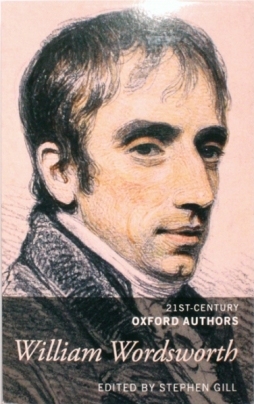 If the Ode was a poem about thinning, this is a poem focusing on transformation. Nature again is the agent of change, forcing a metamorphosis on the poet/visionary. There is a danger here of a kind of thinning in the poet’s mind (which the Ode suggests might then be reflected back onto nature), but those that maintain the faith in nature will find that the transformed nature of their visionary awareness gives them new kinds of power that compensate for the loss of the old.
If the Ode was a poem about thinning, this is a poem focusing on transformation. Nature again is the agent of change, forcing a metamorphosis on the poet/visionary. There is a danger here of a kind of thinning in the poet’s mind (which the Ode suggests might then be reflected back onto nature), but those that maintain the faith in nature will find that the transformed nature of their visionary awareness gives them new kinds of power that compensate for the loss of the old.
To me, this all fits in neatly with the plot structures Clute identifies in fantasy. I think Wordsworth is trying to express aspects of life, or least of his life, that are close to the mythic. He therefore uses mythic language, and mythic plot motifs — as I’ve said, the same motifs that later turned up in fantasy fiction.
Next time, I’ll look closely at The Prelude, and point out another key motif in Wordsworth that I think is significant in a fantasy context; and I’ll try to articulate why I think Wordsworth’s poetry is significant for modern fantasy.
Matthew David Surridge is the author of “The Word of Azrael,” from Black Gate 14. His ongoing web serial is The Fell Gard Codices. You can find him on facebook, or follow his Twitter account, Fell_Gard.
Your article is, as always, rich in historical detail and literary relevance. I particularly enjoyed reading this one because it helped me to understand the importance of Wordsworth to British Romanticism and, consequently, to the development of fantasy as a literary genre in itself.
I had never before read an article that pointed out elements of fantasy in the poetry of Wordsworth, and I confess I was quite surprised to realize that he employed those elements, if not at a conscious level, at least as a recurrent undertone that seemed to enrich his language and his poetical images.
I remember having learned at school that Wordsworth was a conventional, predictable and conservative poet against whose style many poets of the late 19th century rebelled. When I read his poems I didn’t entirely agreed with what was taught to me, but now that I’ve read your article I intend to look for my volume of The Collected Poems of Wordsworth and go through it with your article in mind. I think this will lead to a renewal of my appreciation of his poetry.
I’m looking forward to reading your next article in this series.
[…] Romanticism-and-Fantasy:-William-Wordsworth-Part-One […]